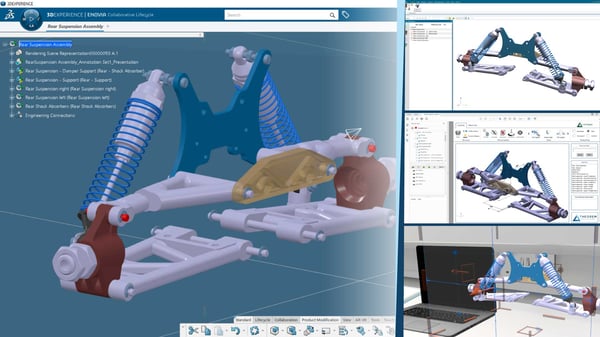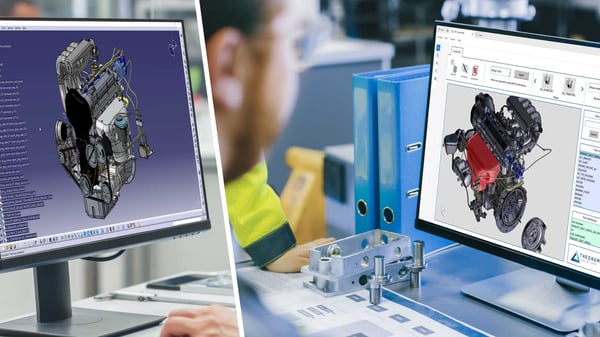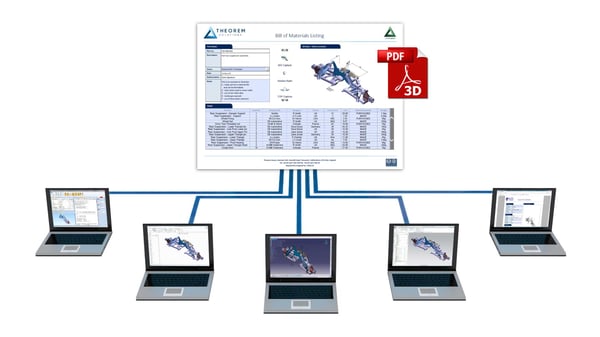Firstly, we need to ascertain what a 3D PDF is; a 3D PDF is a lightweight document that holds your 3D CAD data as a native PDF. It can be used to show engineering data such as CAD geometry, annotations, measurements and bills of materials (BOMs). It is essentially CAD inside a PDF (a Portable Document Format file, developed by Adobe and accessible via the Adobe Reader application).
As it is a PDF, it provides information in a manner independent of application software, hardware, and operating systems. And it is specifically this attribute of the tool, that I will focus on in this blog.
In many businesses, corporate IT will restrict access to computer applications. In fact, to make their lives easier it is not in their interest to add additional software to their IT estate as this is just another thing that needs to be purchased, maintained, tested (against operating system updates), etc. Accordingly, a corporate IT department will often ask for a very thorough and lengthy request form to be completed, which details why you need it, why you can’t use something else, initial (CAPEX) and ongoing (OPEX) costs, etc. So, what if there was a way, to meet your business need, without needing a new application?
So, as I suggested a couple of paragraphs ago, you can have CAD inside a PDF. This means that there is no specialist software to be installed on the computers of those that need to consume the content. Only the authors of the content need the CAD and the 3D PDF tool. Everyone else just needs the free Adobe Reader which is often on every work-place computer as part of the standard build.
This is incredibly useful. When engineering departments need to collaborate with other departments or the wider supply chain, their 3D CAD files are often too large for transfer. Moreover, it is rare that the consumers of this content need access to the full-fidelity 3D CAD, so a secure ‘lightweight’ representation, contained within a PDF file, is an absolutely ideal solution. Unlike the full 3D CAD file, a PDF allows you to create a CAD representation without size restraints. Moreover, by not transferring the original BREP (Boundary Representation) CAD you are not putting your IP at risk.
Accordingly, a 3D PDF adds an increased level of data security; intellectual property is protected as the original CAD data is never shared.
Of course, there are other low-cost ways to consume the 3D CAD in a lightweight format. Siemens have the JT2Go application, for which there is no cost, and JT has the benefit of being an ISO standard. Additionally, Microsoft has a free 3D viewer, which allows a user to view a FBX file. But, there are limitations.
Firstly, these are applications that will need to be installed. They are both great applications and offer many benefits, but they still require your IT department to install this “free” software on the computers of your down-stream users which will still need to be tested and maintained. The Microsoft application, for example is Windows 10 only, and you may not yet be on the most current operating system…
Secondly, whilst these applications allow you to view the 3D model, in a lightweight format, many of the features that exist in a 3D PDF are missing, for example product manufacturing information (PMI) required for production.
Theorem Solutions offer templates with our 3D PDF products. The real power of what can be achieved is via these templates. For example, a work instruction 3D PDF can take a user step-by-step through the assembly/disassembly of a product a step at a time providing all of the guidance that they require. Other examples, all of which can be templated, are requests for quotations, technical data packages or engineering change requests. All of these contain full fidelity, IP protected models. These are not the only templates that Theorem can offer, for more information on the art of the possible, please visit the 3D PDF section of our website.
Adobe Reader is an application that is usually part of a standard build by the IT department (it can be found on 98% of computers, worldwide) so there is no need to ask for additional software, yet your down-stream users can still use 3D product information from your CAD system...
…that’s why you should want to use 3D PDF!



